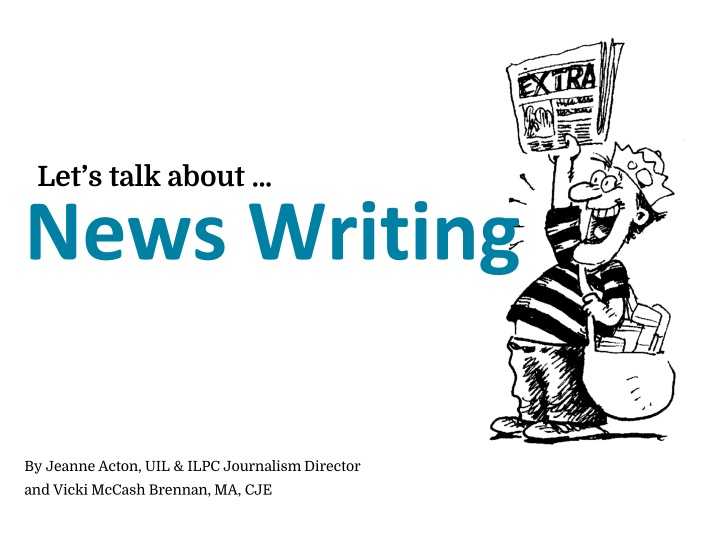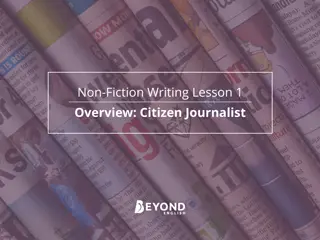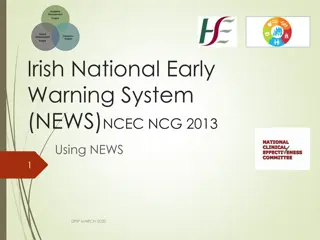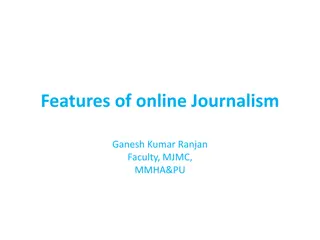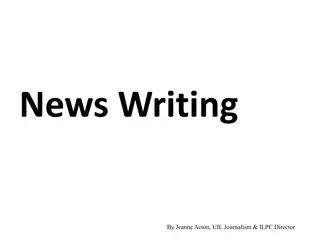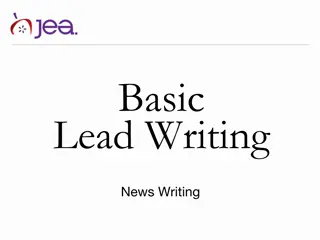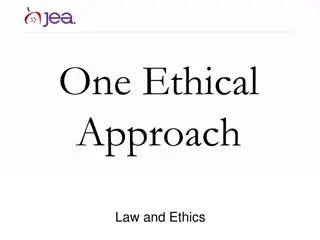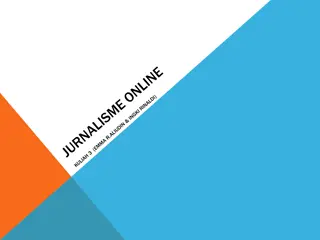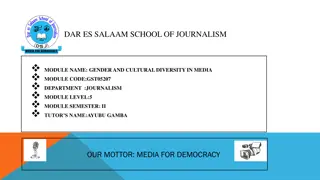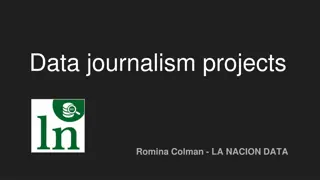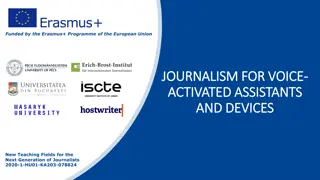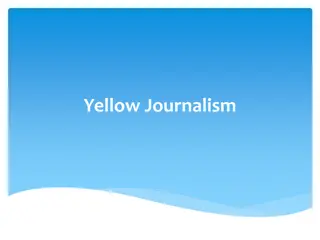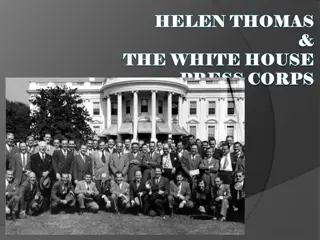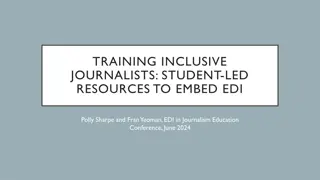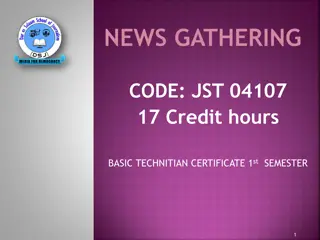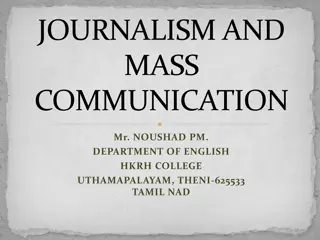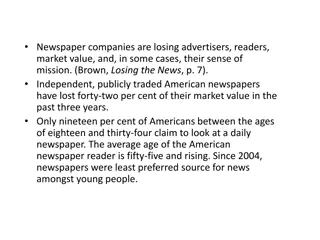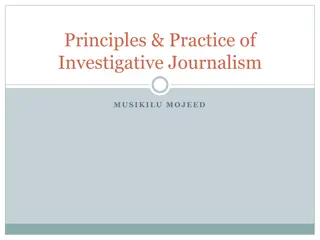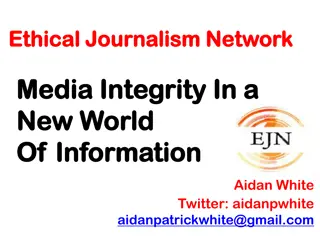Mastering News Writing Structure for Effective Journalism
Dive into the world of news writing with insights from Jeanne Acton and Vicki McCash Brennan. Explore the essential elements of news structure, learn about different models like the Inverted Pyramid and Wall Street Journal format, and discover how to engage readers effectively with factual information.
Download Presentation

Please find below an Image/Link to download the presentation.
The content on the website is provided AS IS for your information and personal use only. It may not be sold, licensed, or shared on other websites without obtaining consent from the author.If you encounter any issues during the download, it is possible that the publisher has removed the file from their server.
You are allowed to download the files provided on this website for personal or commercial use, subject to the condition that they are used lawfully. All files are the property of their respective owners.
The content on the website is provided AS IS for your information and personal use only. It may not be sold, licensed, or shared on other websites without obtaining consent from the author.
E N D
Presentation Transcript
Lets talk about News Writing By Jeanne Acton, UIL & ILPC Journalism Director and Vicki McCash Brennan, MA, CJE
News Writing gives the reader factual information that will affect them or interests them in some way. Informative Interesting Factual
News Writing News provides readers with all of the five W s and H, usually in the lead or near the top of the story. Leads should begin most often with the what, why or who (if interesting or well-known), NOT with when or where, which are usually the least interesting elements. But where do you go from there?
Lets talk about news writing structure.
Disadvantages: It can get repetitive. It might discourage you from a more creative lead. It can get bogged down with facts and details. Advantage: It condenses information efficiently, letting readers understand the basics of what happened quickly and easily.
News Writing A better way . The next structure is a modification of the inverted pyramid that allows for more flexibility and is easy for beginning journalists to use. Use the Transition - Quote (L-Q-T-Q) model for most of your work in journalism.
Another model: Modified Inverted Pyramid Also called the hourglass or the martini glass. Starts with a summary of the event and key facts. Transitions to a narrative or chronological format. Works best for crime or disaster stories when you need to tell what happened from beginning to end.
Another model: The Wall Street Journal format Also called the kabob or the circle Starts with an anecdote about someone who is affected by a trend, issue or event. Uses a nut graph or summary paragraph right after the anecdote to tell the five W s and H. Continues with details and quotes. Ends with a closing anecdote about the same person who is in the lead. Best used for feature writing or follow-up news stories.
For beginning newswriting, it s best to master the L-Q-T-Q formula first. So let s explore that one
Lets talk about Direct Quotes
Direct Quotes Quotes should be linked to the paragraph before them. The quote should elaborate on the previous paragraph. For example: After long-time school nurse Emma Stilten died in a car accident in December, part-time teacher aide Betty Figgs covered Stilten s responsibilities. Impressed with Figgs competence, Principal Stella Reeves proposed keeping Figgs instead of hiring a new nurse. With the savings, Reeves wants to hire a new teacher a move supported by teachers. I thought the parents would jump on board with this proposal, Reeves said. It will decrease our class sizes and benefit students directly.
What comes next? A transition paragraph, adding details. Parent Raquel Simones said the school should not compromise student safety simply to give teachers a few less papers to grade. What comes next? From whom?
Another direct quote elaborates on previous transition Parent Raquel Simones said the school should not compromise student safety simply to give teachers a few less papers to grade. I have a special needs child who is quite fragile, Simones said. If he suffers a seizure at school, I want a certified nurse to help him. The writer continued with the same speaker. That helps with organization. What follows this?
More transitions and quotes (Each quote is linked with a transition above and below it.) Junior GiGi Smith said she also believes the school needs a full-time, certified nurse. Her brother, who will be a freshman next year, has a severe peanut allergy. A nurse is trained to deal with this medical condition, Smith said. A teacher s aide isn t. I like Ms. Figgs, but she could panic. That would be very bad for my brother.
Direct Quotes Should not repeat the transition before them. For example: Figgs said most of her job is distributing prescribed medicine to students. Most of what I do is distribute medicine to students, she said. This is called a stutter quote. AVOID THIS!
Direct Quotes Quotes can be longer than one sentence. Put the attribution after the first sentence of the quote. (In other words, break the quote in half with the attribution in the middle.) Attribution should be: Noun then verb. For example: Correct - senior Bob Rodriguez said. Incorrect - said senior Bob Rodriguez. (unless you have an unusually long title) Do not place two people s direct quotes next to each other without a transition.
Direct Quotes Add emotion, opinions and life to your story. Listen for quotes that tell you how people feel or think about the subject. Don t quote people on dry, basic facts or description that you can observe with your own eyes. Use facts and description in your transitions.
Lets talk about Transitions
Transitions ARE VERY IMPORTANT. Hold the story together. Link the paragraphs, building bridges of understanding for your readers. Provide organization and flow. Help create voice. And in news writing, they re really not too difficult!
Hierarchy of Transitions 1. Basic transition words (Good) First, next, then 1. Transitional phrases (Better) For one thing For instance 1. Internal transitions (Best. Go for these!) Seamless wording embedded within text Use facts, partial quotes and indirect quotes to create these.
Transitions in news writing Can be fact, indirect quote or a partial quote. For example: FACT TRANSITION After long-time school nurse Ema Stilten died in a car accident in December, part-time teacher aide Betty Figgs covered Stilten s responsibilities. Impressed with Figgs competence, Reeves proposed keeping Figgs to avoid hiring a new nurse. With the savings, Reeves wants to hire a new teacher a move supported by teachers.
Transitions Can be fact, indirect quote or a partial quote. For example: INDIRECT QUOTE TRANSITION Parent Raquel Simones said the school should not compromise student safety simply to give teachers fewer papers to grade.
Transitions Can be fact, indirect quote or a partial quote. For example: PARTIAL QUOTE TRANSITION Reeves said Figgs has done an outstanding job since she took over in the nurse s office.
Transitions Use transitional words to help with the flow as needed. Transitional words include after all, also, finally, in addition, however, otherwise, then. For example: In addition to cutting the nursing position, Reeves suggested decreasing the number of bus routes.
Transitions Can show: Time Place Reasons Surprise (a twist) Contrasts Other connections To find a transition, look for a connection.
Transitions Time transitions Afterwards, beforehand, later, soon, meanwhile Place transitions In the room, at the beach, down the hall Contrasts Nevertheless, even though, although Reasons Because of, instead of Connections Repeat a key word, concept or phrase from the previous sentence or paragraph. This is what using partial quotes or indirect quotes can do for you.
Transitions The transitions are in your notebook! Quotes and facts are good for more than just stringing together and calling it a day Use parts of the direct quotes to create the transition. And then use the rest of the quote as the direct quote.
For example I never imagined this would become a permanent solution, but Betty Figgs is doing an excellent job balancing both the classroom and nurse s office, Reeves said. She is very organized and handles all issues professionally and efficiently. We have not received a single complaint about the change. It actually wasn t my idea to continue with this plan. It was Ms. Figgs. She loves the additional duties and feels more than competent to continue next year. Ms. Figgs raised six children, so she knows a little about sick teenagers. Plus, she agreed to seek additional training this summer. The school has not received a single complaint about Figgs since she took over the nurse s job, Reeves said. She is very organized and handles all issues professionally and efficiently, Reeves said. Plus, she agreed to additional training this summer. The Transition Direct Quote
ENDINGS Save a summary quote or a well-said phrase to end with. This is called a kicker quote. DO NOT, under any circumstances, fall back on your essay training and write your own summary conclusion. This is editorializing and it has no place in news writing. Avoid ending with a clich , such as That s all, folks. End with a bang. Save the powerful quote or phrase for last.
Lets Review Following a transition, what should a direct quote do? What types of leads should you use more? Where should you place the attribution for a direct quote? What can a transition be? What is the purpose of the transition? How many sentences can a direct quote be? What can you use to create transitions?
No-Nos for News Stories Using the name of your school or town. Your readers know where they are. Starting with The School Board or some other boring who. Adding facts for which you have no source or making things up because you think that s right. Putting attribution before the quote. Missing the news peg. Missing important information and people. Stacking quotes. Use transitions between each quote! Forgetting to use student quotes. Ending with your own summary.
Checklist for News Stories Are the most important and recent facts first? Is the story accurate? Are the sources identified fully? Are the paragraphs short? Is the sentence structure varied in the story? Is the story neat and double-spaced so that it is easy to read? Does your story flow? Did you use the transition/quote (L-Q-T-Q) formula? Did you use active voice?
Pitfalls to Avoid ** Editorializing. Keep your opinion out of the story Using first and second person. Keep yourself out of the story. Common error: our school. No personal pronouns! Messy handwriting, poor grammar and spelling. Paragraphs too long. Use only one thought or idea per paragraph. New paragraph for each transition and each speaker. Misspelling names. Trying to use all of the information and quotes you have. Be judicious. ** How to get an D/F or lose a competition
What will make the difference? ** Get the news peg in the lead. Use the L-Q-T-Q formula. Use the right sources and strong quotes. ** How to get an A or win a competition
Presentation can end here. Next slide provides critique practice.
What went wrong with this? At Leaguetown High School about 35 students skipped at least one period each school day. The assistant principals said many of the skippers hide in bathrooms, outside the school or in their cars. To reduce truancy, all students will receive new school IDs with built-in tracking devices on April 2, but one parent is working with the American Civil Liberties Union to stop the use of such devices. This is a blatant violation of my son s privacy rights, said parent Don Cantrell. He doesn t want someone watching him at all times. No child in the United States should be tagged or tracked. But Strobinski, who proposed the new IDs, doesn t understand the concerns. She said, We will never use the tracking device on them [students] unless they are skipping class or there is an emergency of some type. Plus, the tracking only works at the school. With the new IDs, administrators will be able to track our students for a range of 200 yards from the principal s office. Students will be less likely to skip if they know we can find them quite easily, Strubinski said. Students should not have any concerns if they don t skip class. Students who have never skipped should not have to wear such an ID, sophmore Johnny Rains said.
